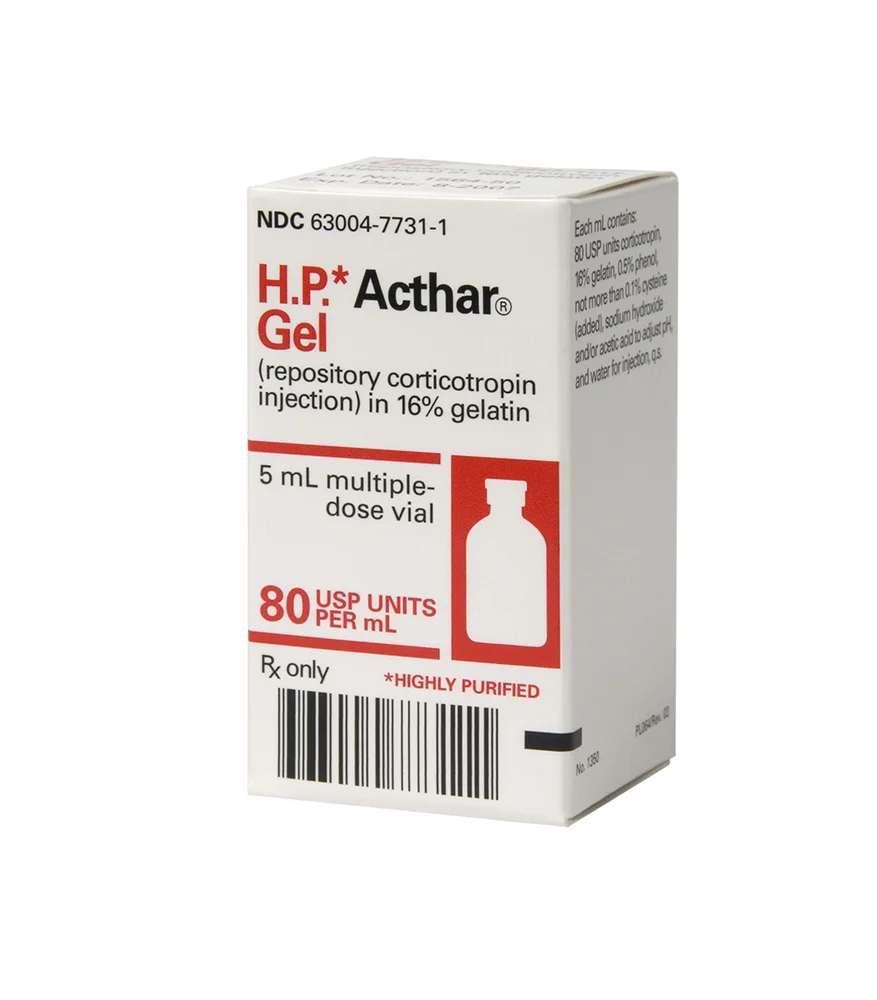A pilot study to determine the dose and effectiveness of adrenocorticotrophic hormone (H.P. Acthar® Gel) in nephrotic syndrome due to idiopathic membranous nephropathy.
Hladunewich MA, Cattran D, Beck LH, Odutayo A, Sethi S, Ayalon R, Leung N, Reich H, Fervenza FC.
PMID: 24714414.
#OpenAccess paper
#NephJC tweet Chat on Aug 12th, 9 pm EDT
Slide Deck Summary
What is H.P. ACTHAR Gel?
It is a natural ACTH formulation prepared from an animal source (H.P stands for highly purified). ACTH as a medicine has been around for a long time, mainly used for diagnosis of related endocrine disorders. It is a 39 amino-acid peptide; another similar but synthetic 24 AA peptide is available in Europe, called cosyntropin. A great review article on this topic (#openaccess) is available here. ACTH is released from the anterior pituitary gland in response to corticotrophin releasing hormone. ACTH stimulates the adrenal gland to release cortisol, corticosterone, aldosterone and a few weakly androgenic substances. It has been used therapeutically for infantile spasms for many years, and only in recent years has it been re-examined for use in auto-immune diseases, notably multiple sclerosis and now glomerulonephritis. One of the questions surrounding ACTH is why a drug that acts to release endogenous cortisol would be a more efficacious auto0immune drug than cortisol itself. One hypothesis is that it may have a better safety profile compared to steroids. Though the evidence does not seem robust, it may be worth testing this hypothesis. The elephant in the room, of course, is its cost. A five dose vial costs $32,000! This has been examined by the New York Times a couple of times. Charles Ornstein of ProPublica.org has been leading much of this coverage.
https://twitter.com/PamBelluck/status/496402453760196608
Study Design
This study was done at Toronto, Canada and the Mayo Clinic in Rochester, MN. It’s a phase 1b/2 dose finding study - so inherently open label, non-blinded. Patients were randomized to one of two different doses of ACTHAR gel, but, as we shall see, there was some contamination. The study was funded by the drug manufacturer, Questcor Pharmaceuticals, through an unrestricted grant (so they had no role in design, conduct, analysis or writing).
The study population consisted of idiopathic membranous nephropathy patients - so no one with SLE, hepatitis or malignancy. In order to be enrolled patients needed to be either treatment naive, or patients who had adverse effects to standard immunosuppressive regimens. Patients with documented resistance to cytotoxic - or calcineurin inhibitors were excluded, though patients with a partial response were still eligible.
Methods
In this study, the patients were randomized to receive either 40 or 80 units per dose, starting twice a week, and advancing to once a week then once every two weeks, for a total of 22 doses in 12 weeks. However, what actually ended up happening was that none of the patients receiving 40 units responded at the end of twelve weeks; at Toronto (4/9 patients) this is when treatment was stopped (cumulative dose 880 units). At the Mayo the 5 (of 9 randomized to 40 units per dose) were then given 80 units per dose, twice a week, for another 12 weeks (cumulative dose 2800 units). The 11 patients randomized to 80 units per dose, received just that, with a cumulative dose of 1760 units.
Results
The proteinuria reduced overall significantly, from 9.1 g/day to 6.2 g/day by end of treatment, and 3.9 g/day at one year. In terms of more granular data, 13/20 patients had a > 50% reduction in proteinuria at 1 year, with 2 achieving a complete and 10 a partial remission.
Given that this was an open label, dose finding study, there is some further post hoc exploratory analysis.
- The cumulative dose of ACTH received showed a significant trend with final proteinuria, with the highest dose (2800 units - those who received 40 units for 3 months then 80 units for another 3 months) showing the greatest reduction (figure 2).
Does ACTHAR have a good safety profile?
None of the 20 patients needed to discontinue the drug for adverse events. Having said that, there were some steroid-like safety events:
3 patients developed cushingoid appearance
6 patients each had transient insomnia and psychological effects (irritability, depression, improved mood)
7 had GI symptoms
13/20 developed hyperglycemia, and in one it was sustained enough to require dietary counselling - though it resolved with just that + weight loss
The authors don’t comment on the relation of these adverse events with the cumulative dose - which would be interesting to see.
What about the anti-PLA2R?
An excellent overview of the development and current status of anti-PLA2R in idiopathic membranous nephropathy can be found here which was written by Joel Topf and Bilal Saleem for the cJASN eJC. In this study, the investigators used a Western Blot assay, using both human glomerular extracts as well as recombinant PLA2R to test these levels. Overall, of the 20 patients, 15 (75%) had detectable levels of the antibody, in keeping with the range described in the overview by Joel and Bilal. Of these, in 3 patients the antibody cleared completely and in another 4, there was a reduction in antibody levels. Overall, the antibody levels correlated very closely with the proteinuria (figures 3 and 4).
Conclusions
The authors conclude that ACTHAR seems safe and may be effective at higher doses in treatment of iMN - but larger RCTs are needed, to confirm efficacy in comparison to standard therapy and also for longer term safety profile.

